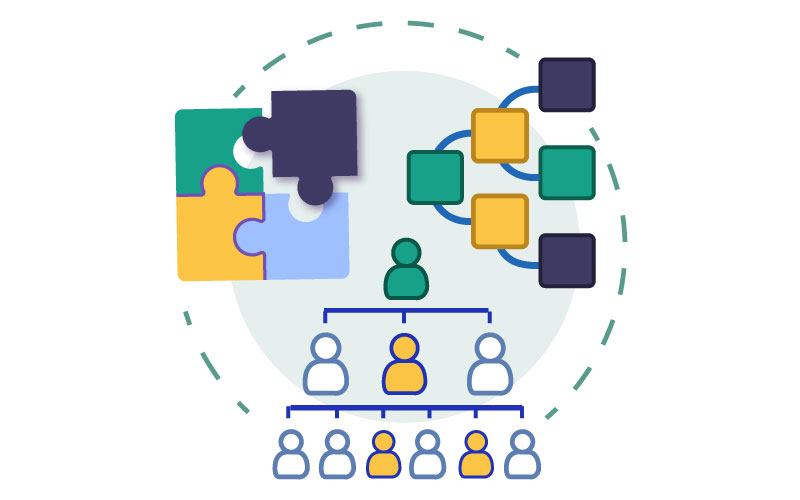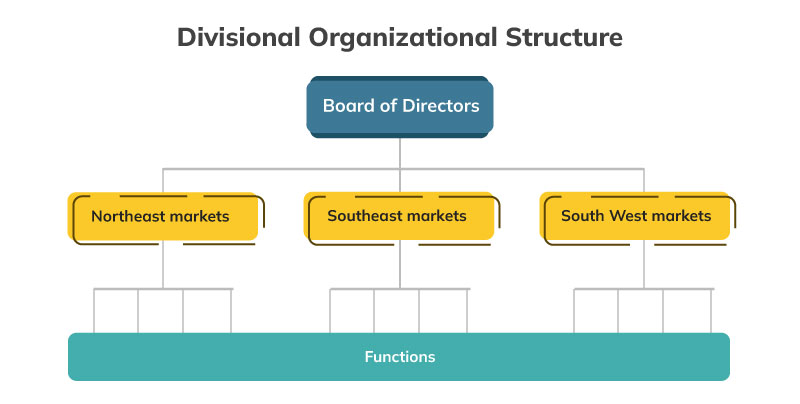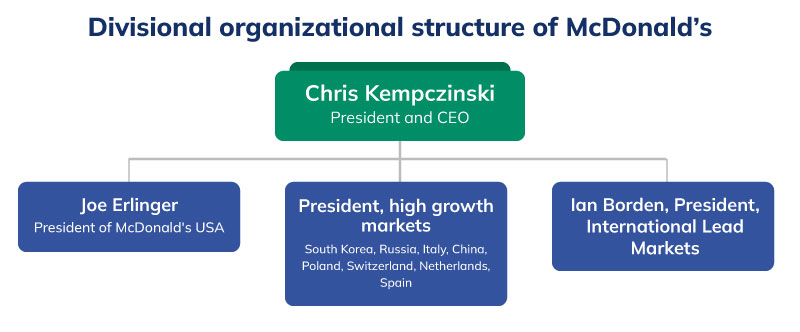Introduction to Divisional Organizational Structure
The term “division” implies the separation of something into different parts or components. The same is the case with the divisional organizational structure in which the different operations of the organization are segregated in different divisions like product-based divisions, geographic divisions, etc.

The divisional organizational structure provides a clear pattern of accountability and helps in decentralizing the organizational operations. The divisional organizational structure can also help in better managing various operations by classifying business operations based on the product, geographical locations, or markets.
Table of Contents
Market-based divisional organizational structure- The organizational operations can be organized based on the markets, customer types, and industry.
Product-based divisional organizational structure- The organizational divisions can be separated by the product line i.e. based on different products of the organization.
Geographic-based divisional organizational structure- The Geographic-based divisional organizational structure includes organizational divisions based on the regions, territories, or districts.
For instance, the organization selling pharmaceutical products in Northeast, Southeast, and Southwest markets can use the divisional organizational structure to organize the organizational operations based on the geographical markets. Further, each division of the organization can be managed by the divisional heads. The divisional organizational structure is represented as follows-

The use of the divisional organizational structure is mainly suitable for large companies having different products or operations in different markets. The use of the divisional organizational structure helps the organization to effectively manage the operations around the product, service groups, geographical markets, etc. For instance, Microsoft uses the product type divisional structure where Microsoft uses the products as the main criterion for grouping its organizational processes. The product-based divisions of Microsoft include productivity and business processes, personal computing, and intelligent cloud.
Advantages of Divisional Organizational Structure
The functional organizational structure is not suitable for large organizations and if the organization wants to diversify, the divisional organizational structure is most suitable as divisional organizational structure whether product-based or market-based provides the opportunity to the organization to diversify or easily set up another division. The divisional organizational structure has several benefits for the organizations which are discussed as follows-
Accountability and transparency- In a divisional organizational structure, each division has its managerial head who makes the employees accountable for their actions. Moreover, the performance of each division is separately reported and each division is also responsible for managing the performance of the specific division which also helps to ensure transparency.
Company culture- The divisional organizational structure can also help to improve the organizational culture by facilitating clear roles and responsibilities for each employee.
Organizational performance- Divisional organizational structure also helps to ensure the growth and profitability of the organization by placing responsibilities at the divisional level and freeing up the top management to concentrate on strategic matters. The increase in the accountability and transparency of the organization can also help to ensure higher business performance.
Disadvantages of Divisional Organizational Structure
While there are many advantages of divisional structure but there are some disadvantages also which need to be considered while adopting the divisional organizational structure. The major disadvantages of divisional organizational structure are discussed as follows-
Cost of operations- The overall cost of operations can be very high in the divisional organizational structure as the organization will still require a centralized corporate division to oversee the operations of the whole organization. Moreover, various functions like human resources and accounting will be required to be managed centrally which can also increase the cost of the centralized function.
Duplication of resources- The chance of duplication of the resources is very high in the divisional organizational structure as operations of the organization are managed in different divisions and there is a lack of consideration of available resources by different divisions.
Competition between divisions- The divisional organizational structure can also lead to an increase in competition between the divisions as each divisional head may focus on increasing the overall performance of its division and distribution of company budget based on the performance of each division can cause gaps between the divisions. Moreover, the Silo mentality can also be created as a result of divisional organizational structure which can also result in problems in integration between various divisions.
Example of Divisional Organizational Structure
One of the good examples of Divisional organizational structure is the organizational structure of McDonald's as beside the hierarchical organizational structure in McDonald’s, McDonald's manages its performance based on the performance-based divisions which include the US, Asia Pacific, Europe, Middle East, and Africa, and other which further include Canada, Latin America, and Corporate divisions. Every division has its enactment which includes finance, marketing, sales, and IT. The organizational structure of McDonald’s is represented as follows-

The geographic divisional organizational structure helps to effectively manage the global performance of McDonald’s. Also, the divisional organizational structure helps the company to implement the strategies specific to the local market which further helps in enhancing the organizational performance. For instance, McDonald’s food menu also differs significantly across countries. The meat from the chicken thighs is used in the chicken burger of McDonald’s due to the local preference of the customers. Along with this, the ad campaigns of McDonald’s also differ across its markets. Hence, the divisional organizational structure helps McDonald’s to focus on the local market needs and ensure effective decision making.
FAQs
How does a divisional organizational structure differ from a functional structure?
In a functional organizational structure, the organization is organized based on specialized functions (e.g., marketing, finance, human resources), and employees are grouped according to their expertise. In contrast, a divisional structure groups employees into self-contained units based on products, services, customers, or geographic regions, which allows for a more focused and market-oriented approach.
How does a divisional structure promote innovation and creativity?
A divisional structure can promote innovation and creativity by empowering divisions to develop unique approaches to problem-solving and product development. Each division can tailor its strategies to fit the specific needs of its market or customer segment, fostering an entrepreneurial spirit within the organization.
Previous Structure
Functional Organizational StructureNext Structure
Hybrid Organizational Structure
 Proof Reading
Proof Reading  Copy Writing
Copy Writing  Resume Writing
Resume Writing  Blogs
Blogs Guides
Guides SOP's
SOP's Student Resources
Student Resources Research Topics
Research Topics Login
Login Register
Register